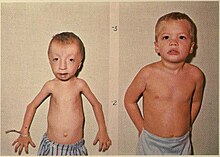Seckel syndrome
| Seckel syndrome | |
|---|---|
| Other names | Harper's syndrome |
 | |
| Boy with Seckel syndrome (left) | |
| Specialty | Medical genetics |
| Causes | defects of genes on chromosome 3 and 18. |
Seckel syndrome, or microcephalic primordial dwarfism (also known as bird-headed dwarfism, Harper's syndrome, Virchow–Seckel dwarfism and bird-headed dwarf of Seckel[1]) is an extremely rare congenital nanosomic disorder. Inheritance is autosomal recessive.[2] It is characterized by intrauterine growth restriction and postnatal dwarfism with a small head, narrow bird-like face with a beak-like nose, large eyes with down-slanting palpebral fissures,[3] receding mandible and intellectual disability.
A mouse model has been developed.[4] This mouse model is characterized by a severe deficiency of ATR protein.[4] These mice have high levels of replicative stress and DNA damage. Adult Seckel mice display accelerated aging.[4] These findings are consistent with the DNA damage theory of aging.
Symptoms and signs
[edit]Symptoms include:[5]
- intellectual disability (more than half of the patients have an IQ below 50)
- microcephaly
- sometimes pancytopenia (low blood counts)
- cryptorchidism in males
- low birth weight
- dislocations of pelvis and elbow
- unusually large eyes
- blindness or visual impairment
- large, low-set ears
- small chin due to receded lower jaw
Genetics
[edit]It is believed to be caused by defects of genes on chromosome 3 and 18. One form of Seckel syndrome can be caused by mutation in the gene encoding the ataxia telangiectasia and Rad3-related protein (ATR) which maps to chromosome 3q22.1–q24. This gene is central in the cell's DNA damage response and repair mechanism.
Types include:[6]
| Type | OMIM | Gene | Locus |
|---|---|---|---|
| SCKL1 | 210600 | ATR | 3q23 |
| SCKL2 | 606744 | RBBP8 | 18q11 |
| SCKL4 | 613676 | CENPJ | 13q12 |
| SCKL5 | 613823 | CEP152 | 15q21.1 |
| SCKL6 | 614728 | CEP63 | 3q22.2 |
| SCKL7 | 614851 | NIN | 14q22.1 |
| SCKL8 | 615807 | DNA2 | 10q21.3 |
| SCKL9 | 616777 | TRAIP | 3p21.31 |
| SCKL10 | 617253 | NSMCE2 | 8q24.13 |
| SCKL11 | 620767 | CEP295 | 11q21 |
Diagnosis
[edit]There are 4 criteria for diagnosis:[7]
- Congenital Dwarfism and postnatal growth retardation
- Microcephaly, large eyes, beak-like nose, narrow face, retrognathism, malocclusion
- Mental handicap
- Agenesis of the corpus callosum, cerebral cysts
Other abnormalities can be a supportive criteria, such as: anemia, pancytopenia, cleft lip/palate scoliosis or kyphoscoliosis.[8]
Genetic testing can confirm diagnosis.[5]
Treatment
[edit]There is no cure for Seckel syndrome. Symptomatic treatment is available.[9][10]
History
[edit]The syndrome was named after German–American physician Helmut Paul George Seckel[11] (1900–1960). The synonym Harper's syndrome was named after pediatrician Rita G. Harper.[12][13]
See also
[edit]References
[edit]- ^ Harsha Vardhan BG, Muthu MS, Saraswathi K, Koteeswaran D (2007). "Bird-headed dwarf of Seckel". J Indian Soc Pedod Prev Dent. 25 Suppl: S8–9. PMID 17921644.
- ^ James Wynbrandt; Mark D. Ludman (February 2008). The encyclopedia of genetic disorders and birth defects. Infobase Publishing. pp. 344–. ISBN 978-0-8160-6396-3. Retrieved 7 January 2011.
- ^ Jung M, Rai A, Wang L, Puttmann K, Kukreja K, Koh CJ (2018). "Nephrolithiasis in a 17-Year-Old Male With Seckel Syndrome and Horseshoe Kidneys: Case Report and Review of the Literature". Urology. 120: 241–243. doi:10.1016/j.urology.2018.05.023. PMID 29894776. S2CID 48353132.
- ^ a b c Murga M, Bunting S, Montaña MF, et al. (August 2009). "A mouse model of ATR-Seckel shows embryonic replicative stress and accelerated aging". Nat. Genet. 41 (8): 891–8. doi:10.1038/ng.420. PMC 2902278. PMID 19620979.
- ^ a b "Seckel Syndrome - Symptoms, Causes, Treatment | NORD". rarediseases.org. Retrieved 2025-01-10.
- ^ "Entry - #210600 - SECKEL SYNDROME 1; SCKL1 - OMIM". omim.org. Retrieved 2025-01-10.
- ^ Bissonnette, Bruno; Luginbuehl, Igor; Engelhardt, Thomas (2019), "Seckel Syndrome", Syndromes: Rapid Recognition and Perioperative Implications (2 ed.), New York, NY: McGraw-Hill Education, retrieved 2025-01-10
- ^ Bissonnette, Bruno; Luginbuehl, Igor; Engelhardt, Thomas (2019), "Seckel Syndrome", Syndromes: Rapid Recognition and Perioperative Implications (2 ed.), New York, NY: McGraw-Hill Education, retrieved 2025-01-10
- ^ "Seckel Syndrome - Symptoms, Causes, Treatment | NORD". rarediseases.org. Retrieved 2025-01-10.
- ^ Kelana, Andreas Dhymas Dhyna Martha; Windiani, Gusti Ayu Trisna; Arimbawa, Made; Adnyana, Gusti Agung Ngurah Sugitha; Yuda, Made Darma; Murti, Ni Luh Sukma Pratiwi; Soetjiningsih, Soetjiningsih (2023-01-04). "Case of Seckel Syndrome in a 9-month-old Girl". Open Access Macedonian Journal of Medical Sciences. 11 (C): 6–10. doi:10.3889/oamjms.2023.10988. ISSN 1857-9655.
- ^ Seckel, H. P. G. Bird-headed Dwarfs: Studies in Developmental Anthropology Including Human Proportions. Springfield, Ill.: Charles C Thomas (pub.) 1960.
- ^ "Seckel's syndrome".
- ^ Harper RG, Orti E, Baker RK (May 1967). "Bird-beaded dwarfs (Seckel's syndrome). A familial pattern of developmental, dental, skeletal, genital, and central nervous system anomalies". J. Pediatr. 70 (5): 799–804. doi:10.1016/S0022-3476(67)80334-2. PMID 6022184.
